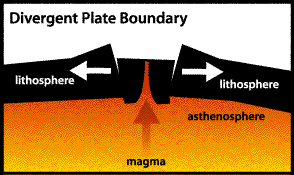Plate Boundaries: Divergent
- Overcoming Science Team
- Nov 11, 2017
- 3 min read

We're done discussing the first main type of plate boundaries which is the Convergent. Convergent Plate boundaries in summarized are the boundaries between tectonic plates crashing towards each other. Now, let's discuss another type of plate boundary but now, it's the moving away of tectonic plates. Have fun.

Continental Divergent Plate Boundary
The second main type of a plate boundaries is the Divergent Plate Boundary. It is a tectonic boundary where two plates are moving away from each other and new crust is forming from magma that rises to the Earth's surface between the two plates. [1]
Divergent plate boundaries are locations where plates are moving away from one another. This occurs above rising convection currents. The rising current pushes up on the bottom of the lithosphere, lifting it and flowing laterally beneath it. This lateral flow causes the plate material above to be dragged along in the direction of flow. At the crest of the uplift, the overlying plate is stretched thin, breaks and pulls apart. [2]
In plate tectonics, a divergent boundary or divergent plate boundary (also known as a constructive boundary or an extensional boundary) is a linear feature that exists between two tectonic plates that are moving away from each other. [3]

Divergent Plate Boundary
Three different definition of divergent plate boundary are stated but all of them have the same thoughts.
Unlike the Convergent plate boundaries, which has three different kinds. The Divergent plate boundaries has only two kinds, the Oceanic and the Continental.
Again, take note that PLATE BOUNDARIES ARE ALWAYS FAULTS, BUT NOT ALL FAULTS ARE PLATE BOUNDARIES.
TWO KINDS OF DIVERGENT PLATE BOUNDARIES
Illustration of Oceanic Divergent Plate Boundary
i. Oceanic Divergent Plate Boundary
When a divergent boundary occurs beneath oceanic lithosphere, the rising convection current below lifts the lithosphere, producing a mid-ocean ridge. Extensional forces stretch the lithosphere and produce a deep fissure. When the fissure opens, pressure is reduced on the super-heated mantle material below. It responds by melting, and the new magma flows into the fissure. The magma then solidifies and the process repeats itself. [2]
Divergent boundaries are typified in the oceanic lithosphere by the rifts of the oceanic ridge system, including the Mid-Atlantic Ridge and the East Pacific Rise. [3] Where a divergent boundary crosses the ocean floor, the rift valley is much narrower, only a kilometer or less across, and it runs along the top of a mid-oceanic ridge. Oceanic ridges rise a kilometer or so above the ocean floor and form a global network tens of thousands of miles long. [4]
As said, two locations are marked: 1) the Mid-Atlantic Ridge exposed above sea level on the island of Iceland, and 2) the Mid-Atlantic Ridge between North America and Africa. [2]
Illustration of Continental Divergent Plate Boundary
ii. Continental Divergent Plate Boundary
When a divergent boundary occurs beneath a thick continental plate, the pull-apart is not vigorous enough to create a clean, single break through the thick plate material. Here the thick continental plate is arched upwards from the convection current's lift, pulled thin by extensional forces, and fractured into a rift-shaped structure. As the two plates pull apart, normal faults develop on both sides of the rift, and the central blocks slide downwards. Earthquakes occur as a result of this fracturing and movement. Early in the rift-forming process, streams and rivers will flow into the sinking rift valley to form a long linear lake. As the rift grows deeper it might drop below sea level, allowing ocean waters to flow in. This will produce a narrow, shallow sea within the rift. This rift can then grow deeper and wider. If rifting continues, a new ocean basin could be produced. [2]
Divergent boundaries are typified in the continental lithosphere by rift valleys such as the famous East African Great Rift Valley. [3] Where a divergent boundary crosses the land, the rift valleys which form are typically 30 to 50 kilometers wide. Examples include the East Africa rift in Kenya and Ethiopia, and the Rio Grande rift in New Mexico. [4]
The East Africa Rift Valley is a classic example of this type of plate boundary. The East Africa Rift is in a very early stage of development. The plate has not been completely rifted, and the rift valley is still above sea level but occupied by lakes at several locations. The Red Sea is an example of a more completely developed rift. There the plates have fully separated, and the central rift valley has dropped below sea level. [2]
References:
[1] www.dictionary.com/browse/divergent-plate-boundary [2] http://geology.com/nsta/divergent-plate-boundaries.shtml [3] https://en.wikipedia.org/wiki/Divergent_boundary [4] http://www.cotf.edu/ete/modules/msese/earthsysflr/plates3.html














































Comments